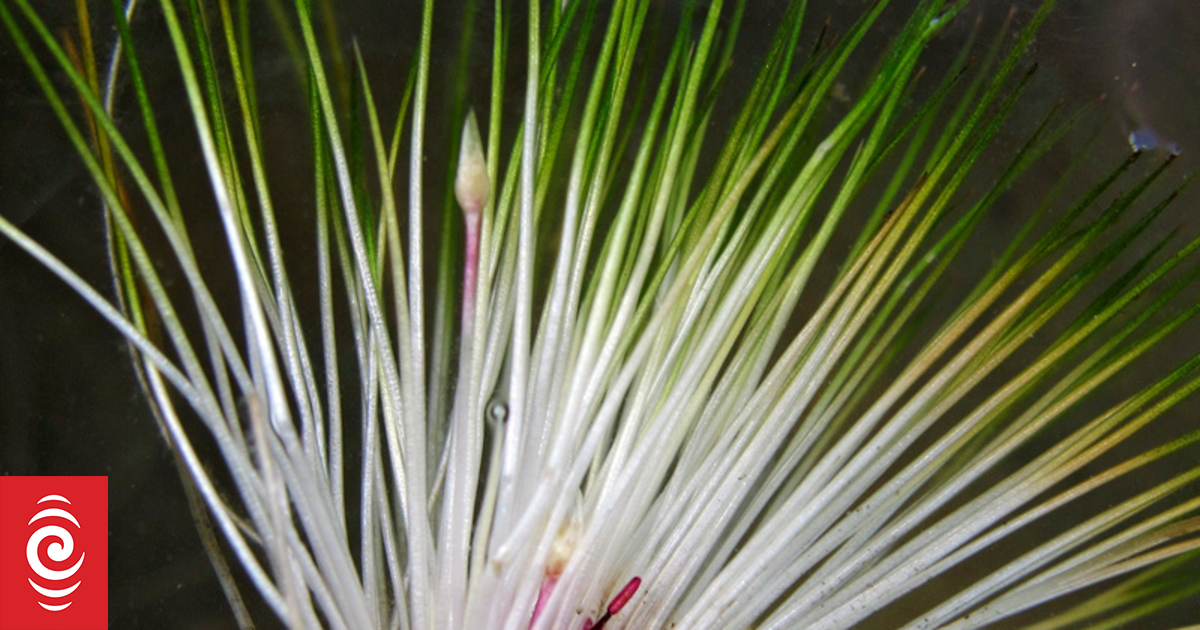
Forget that other election – the 55mm-high, lake-dwelling Trithuria inconspicua has just been voted New Zealand’s favourite plant for 2024.
Photo: NIWA / Dennis Gordon
Forget the voting happening somewhere overseas – here in Aotearoa the winner of another hotly contested, knife-edge election has just been announced.
That, however, is where the similarities end.
The winner of this election is tiny, inconspicuous and inoffensive to the point that few people have even heard of it.
It is also extraordinarily ancient, with a 100-million-year lineage that makes even the sitting US president and his chief challenger look like spring chickens.
The winner of the New Zealand’s Favourite Plant 2024 is an aquatic species so uncommon it does not have a common name, and instead has to go by its Latin moniker Trithuria inconspicua.
Taylor Davies-Colley, who organised the online vote for the New Zealand Plant Conservation Network, said Trithuria inconspicua was a deserving winner.
It was also fitting that this year’s winner was found only in Northland, given that the network’s annual conference had just been held in Whangārei.
Davies-Colley said this year’s winning plant was on the brink of being lost forever.
“Its range has declined hugely, so it’s now found in only five Northland lakes. It’s part of an ancient lineage that includes things like water lilies, and whereas other countries have large, flashy water lilies that everyone cultivates in their ponds, we have this tiny thing that clings onto the bottom of the lakes and is just five centimetres tall.”

The winner of New Zealand’s Favourite Plant 2024, Trithuria inconspicua, is rarely seen and only occasionally felt underfoot.
Photo: SUPPLIED
However, despite its small stature, Trithuria inconspicua was a powerful indicator of ecosystem health.
“The dune lakes of Northland are some of the most amazing pristine ecosystems left in the country. So this species tells us a lot about how our lakes are doing and where we need to focus our work to make sure not only this species continues to survive, but all the other life in these lakes thrives as well.”
Davies-Colley said Trithuria’s humble, inconspicuous nature made it quintessentially Kiwi.
“I think that’s true of a lot of our flora. It’s really cool to see these kind of understated, quiet little champions of their own ecosystems leading the way in this year’s vote. I do think there is something quite New Zealand about that attitude.”
Davies-Colley said the competition, now in its 21st year, aimed to put a spotlight on New Zealand’s 2800 plant species found nowhere on the planet – about half of which were at risk or threatened.
“And unlike flashy or charismatic species like birds, our plants don’t get as much attention or funding, so they’re in real trouble. The vote is a way to hopefully raise awareness a little bit, but also it’s a bit of fun. When you work in conservation, there’s a lot of a lot of tough days. So having a competition to choose a favourite plant is a nice way to lighten things up a bit, and build some community around these really special creatures.”
As for the other election taking place, Davies-Colley said New Zealand’s Favourite Plant 2024 was just as important.
“Trithuria’s win is great for a species that really champions healthy ecosystems. That election that’s happening elsewhere could also result in some differences for ecosystems, if we’re not careful.”
Northland Regional Council biodiversity manager Lisa Forester said this year’s winner lived up to its name, inconspicua.
It grew partly buried in sand on the lake bed, and had fans of fine, hair-like leaves hiding flowers that looked like miniature water lilies.
“It’s so exciting that a Northland aquatic plant has won, and that people know and love this remarkable little plant,” she said.
Unfortunately, the future of Trithuria was uncertain.
As recently as 1998 it was found in 13 dune lakes north of Poutō, but now clung to survival in just five.
Forester said it needed clean sand and water to survive, and was effectively a “canary in the coalmine” warning of deteriorating water quality.
It was threatened by nutrient enrichment, pest weeds and fish, and recreational pressures.
Three of the lakes where Trithuria grew were popular destinations for swimming or boating, putting the plant at extra risk of being trampled or from accidental pest introductions.
Kaumātua Ric Pārore, of Te Kuihi hapū, one of the mana whenua of Kai Iwi Lakes, said he was thrilled to see Trithuria recognised, but sad the plant had become so rare.
“It’s important that everyone who visits or uses our lakes is careful to look after them so this plant can thrive.”
The invasive gold clam, which was now present in Waikato, would almost certainly spell the end of Trithuria if it reached the Kai Iwi Lakes.
See the New Zealand Plant Conservation Network website for this year’s full list of winners.
Sign up for Ngā Pitopito Kōrero, a daily newsletter curated by our editors and delivered straight to your inbox every weekday.



